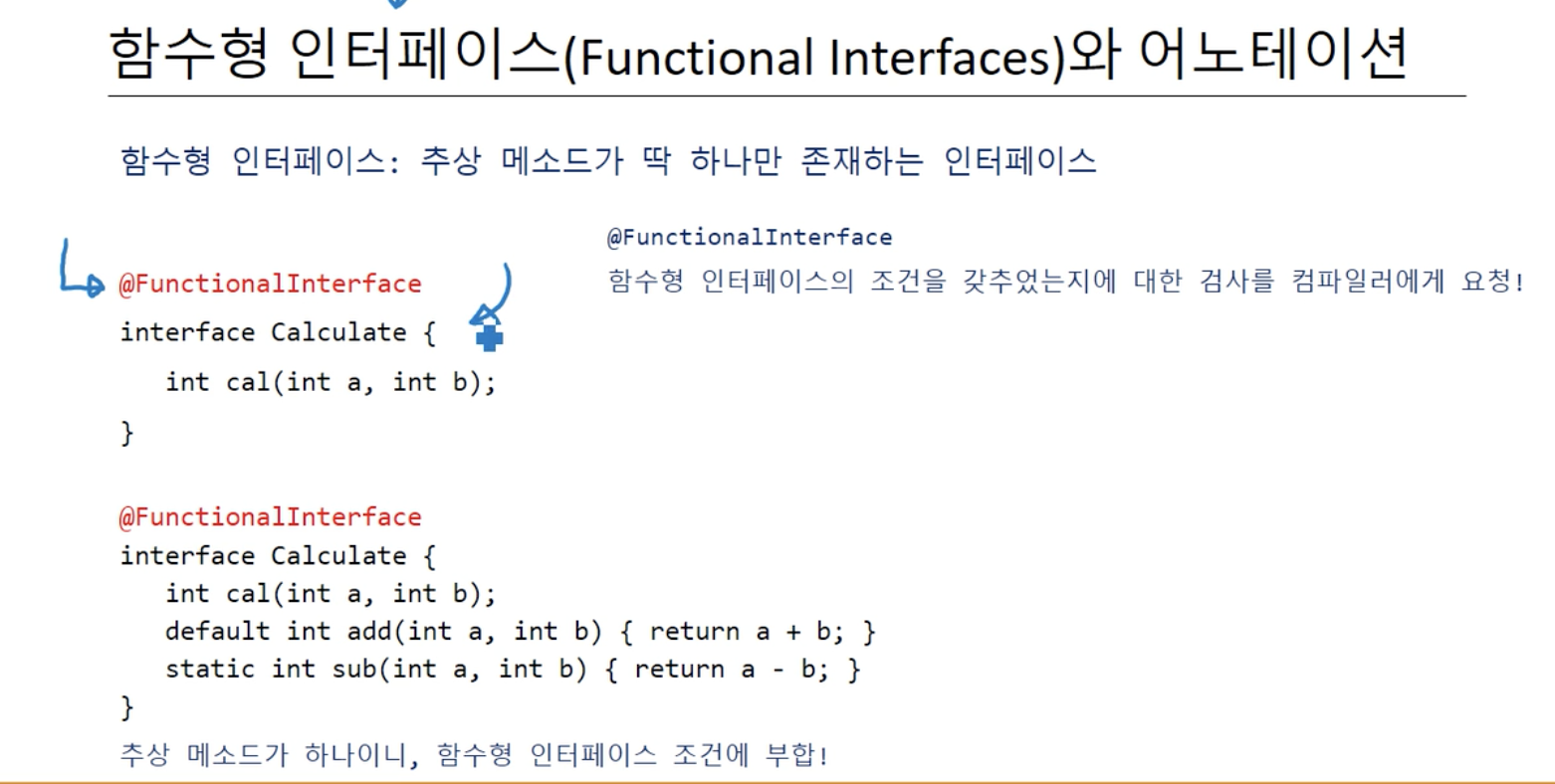
Section 01
Goal
람다 표현식에 대해 다시 한번 정리 해보자.
람다와 함수형 인터페이스
- 추상 메서드가 딱 하나만 존재하는 인터페이스를 함수형 인터페이스라 한다.
- 인터페이스 내에 추상 메서드가 한 개 이상일 시 함수형 인터페이스라 할 수 없다.
인스턴스보다 기능 하나가 필요한 상황을 위한 람다
class SLenComp implements Comparator<String> {
@Override
public int compare(String s1, String s2) {
return s1.length() - s2.length();
}
}
class SLenComparator {
public static void main(String[] args) {
List<String> list = new ArrayList<>();
list.add("Robot");
list.add("Lambda");
list.add("Box");
Collections.sort(list, new SLenComp()); // 첫번째 매개변수는 정렬할 자료 구조, 두번째는 정렬 기준이다.
for(String s : list)
System.out.println(s);
}
}- 메소드 하나가 필요한 상황이라 생각하는게 쉽다.
- 위 상황에서 SLenComp안에 있는 compare 메서드를 사용하기 위해, 인스턴스를 생성 해야만 한다.
- 즉, 위에서 말했다시피 메서드(기능) 하나를 호출 하기 위해 인스턴스를 생성하는 것은 낭비라 할 수 있다.
매개변수가 있고 반환하지 않는 람다식
interface Printable {
void print(String s); // 매개변수 하나, 반환형 void
}
class OneParamNoReturn {
public static void main(String[] args) {
Printable p;
p = (String s) -> { System.out.println(s); } // 줄임 없는 표현
p.print("Lambda exp one.");
p = (String s) -> System.out.println(s); // 중괄호 생략
p.print("Lambda exp two.");
p = (s) -> System.out.println(s); // 매개변수 형 생략
p.print("Lambda exp three.");
p = s -> System.out.println(s); // 매개변수 소괄호 생략
p.print("Lambda exp four.");
}
}중괄호, 소괄호 생략이 불가능한 상황
- 메소드 몸체가 둘 이상의 문장.
- 매개 변수의 수가 둘 이상인 경우.
- 람다식은 코드를 최대한 줄여서 사용하는걸 추천한다.
매개변수가 둘 인 람다식
interface Calculate {
void cal(int a, int b);
}
class TwoParamNoReturn {
public static void main(String[] args) {
Calculate c; // 인터페이스
c = (a, b) -> System.out.println(a + b);
c.cal(4, 5);
c = (a, b) -> System.out.println(a - b);
c.cal(4, 3);
c = (a, b) -> System.out.println(a * b);
c.cal(4, 3);
}
}매개변수가 있고 반환하는 람다식1
interface Calculate {
int cal(int a, int b);
}
class TwoParamAndReturn {
public static vodi main(String[] args) {
Calculate c;
c = (a, b) -> { return a + b; }; // return문의 중괄호는 생략 불가!
System.out.println(c.cal(4, 3));
c = (a, b) -> a + b; // **연산 결과가 남으면, 별도로 명시하지 않아도 반환 대상이 됨!**
System.out.println(c.cal(4, 3));
}
}- 위에서 말했다시피 연산 결과가 남으면, 자동으로 값을 return 하게 된다.
- 또한 return문은 { } 중괄호 생략이 불가능하다.
매개변수가 있고 반환하는 람다식2
interface HowLong {
int len(String s); // 값을 반환하는 메소드
}
class OneParamAndReturn {
public static void main(String[] args) {
HowLong h1 = s -> s.length();
System.out.println(h1.len("I am so happy"));
}
}매개변수가 없는 람다식
interface Generator [
int rand(); // 매개변수가 없는 메소드
}
class NoParamAndReturn {
public static void main(String[] args) {
Generator gen = () -> {
Random rand = new Random();
return rand.nextInt(50);
};
System.out.println(gen.rand());
}
}함수형 인터페이스(Functional Interfaces)와 어노테이션

@FunctionalInterface
- 함수형 인터페이스의 조건을 갖추었는지에 대한 검사를 컴파일러에게 요청!
Example 01
@FunctionalInterface
interface Calculate {
int cal(int a, int b);
default int add(int a, int b) { return a + b; }
static int sub(int a, int b) { return a - b; }
}- default 메소드, static 메소드는 반드시 구현하지 않아도 된다.
- 위 예제에서 추상 메서드는 int cal(int a, int b)다.
- 추상 메서드는 반드시 구현하여야 한다.
추상 메서드란 구현부는 작성하지 않고 선언부만 작성해둔 메소드를 의미한다.
람다식과 제네릭
@FunctionalInterface
interface Calculate <T> {
T cal(T a, T b)
}
class LambdaGeneric {
Calculate<Integer> ci = (a, b) -> a + b;
System.out.println(ci.cal(4, 3));
Calculate<Double> cd = (a, b) -> a + b;
System.out.println(ci.cal(4.32, 3.45));
}- 인터페이스 역시 제네릭 기반으로 작성이 될 수 있다.
- 인터페이스형 참조 변수를 선언할 때 제네릭 타입을 정해주는 것만 신경 쓰면 된다.
- 매개 변수로 들어오는 a, b는 Integer, Double형으로 구성이 된다.
- 즉, 타입 인자만 결정하면 끝이다!!
정의되어 있는 함수형 인터페이스
default boolean removeIf(Predicate<? super E> filter)
-> Collection< E > // 인터페이스에 정의되어 있는 디폴트 메소드
Predicate // 인터페이스의 추상 메소드는 다음과 같이 정의해 두었다.
boolean test(T t);
// 미리 정의해 두었으므로 Predicate라는 이름만으로 통한다!
@FunctionalInterface
public interface Predicate< T > {
boolean test(T t);
}- 여기서 Predicate<? super E>는 인터페이스다??
- 자바 진영에서는 이러한 함수형 인터페이스를 많이 제공 해준다.
대표적인 함수형 인터페이스
Predicate< T >
- boolean test(T t) : 전달 인자를 근거로 참 또는 거짓을 반환.
- Predicate형 참조 변수를 선언 하였을 때 어떻게 대처할지 생각을 해보면 좋을 듯 하다.
Example 01
// 아래 코드는 실제로 작성 해보면 좋을 듯 하다.
public static int sum(Predicate<Integer> p, List<Integer> lst) { // 매개변수를 유심히 보자~~!!
int s = 0;
for(int n : lst) {
if(p.test(n)) {
s += n;
}
}
return s;
}
public static void main(String[] args) {
List<Integer> list = Arrays.asList(1, 5, 7, 9, 11, 12);
int s;
s = sum(n -> n % 2 == 0, list); // test() 메소드의 몸체가 되는 부분이다.
System.out.println("짝수 합 : " + s);
s = sum(n -> n % 2 != 0, list);
System.out.println("홀수 합 : " + s);
}- 첫번째 인자로 Predicate 형식 매개 변수를 받는다.
- 즉, sum() 메소드를 호출 하는 사람이 필요에 맞게 조건을 결정하게 되는 코드.
- 또한, 람다식을 매개 변수로 전달 할 수 있다는 것이 중요하다.
- Predicate p = sum(n → n % 2 == 0) 위 같은 코드가 가능하기에, 매개 변수로 받을 수 있음.
Predicate를 구체화하고 다양화 한 인터페이스들.
autoBoxing, autoUnboxing 과정을 없애기 위해 아래 인터페이스를 만들었다.
IntPredicate
- boolean test(int value)
- int형 인자를 매개 변수로 받는다.
LongPredicate
- boolean test(long value)
- long형 인자를 매개 변수로 받는다.
DoublePredicate
- boolean test(double value)
- double형 인자를 매개 변수로 받는다.
BiPredicate<T, U>
- boolean test(T t, U u)
- 기본적으로 Predicate 인터페이스의 메소드는 인자를 하나만 받지만, 위 메소드를 통해 두 가지를 받을 수 있다.
- Bi가 붙으면 두 가지 정보를 받을 수 있다.
Supplier< T >
- T get() : 메소드 호출 시 무엇인가를 제공함.
- 기부자라 생각을 하자, 받는 것 없이 주기만 한다.
Example 02
public static List<Integer> makeIntList(Supplier<Integer> s, int n) {
List<Integer> list = new ArrayList<>();
for(int i = 0; i < n; i++) {
list.add(s.get()); // 난수를 생성해 담는다.
}
return list;
}
public static void main(String[] args) {
Supplier<Integer> spr = () -> {
Random rand = new Random();
return rand.nextInt(50);
}
List<Integer> list = makeIntList(spr, 5);
System.out.println(list);
list = makeIntList(spr, 10);
System.out.println(list);
}Supplier를 구체화하고 다양화 한 인터페이스들.
autoBoxing, autoUnboxing 과정을 없애기 위해 아래 인터페이스를 만들었다.
IntSupplier
- int getAsInt()
LongSupplier
- long getAsLong()
DoubleSupplier
- double getAsDouble()
BooleanSupplier
- boolean getAsBoolean()
Consumer< T >
- void accept(T t) : 소비만 한다.
- 반환값이 없고 전달 인자만 있는 함수형 인터페이스를 구현 하여야 한다.
Example03
class ConsumerDemo {
public static void main(String[] args) [
Consumer<String> c = s -> System.out.println(s);
c.accept("Pineapple"); // 출력이라는 결과를 보임
c.accept("Strawberry");
}
}Consumer를 구체화하고 다양화 한 인터페이스들
autoBoxing, autoUnboxing 과정을 없애기 위해 아래 인터페이스를 만들었다.
IntConsumer
- void accept(int value)
ObjIntConsumer
- void accept(T t, int value)
LongConsumer
- void accept(long value)
ObjLongConsumer
- void accept(T t, long value)
DoubleConsumer
- void accept(double value)
ObjDoubleConsumer
- void accept(T t, double value)
BiConsumer<T, U>
- void accept(T t, U u)
Function< T, R >
- R apply(T t) : 입출력 출력이 있음(수학적으로는 함수).
- 쉽게 말하자면 T형 인자를 받아서, R형 값을 반환 해준다 생각하자.
Example 04
class FunctionDemo {
public static void main(String[] args) {
Function<String, Integer> f = s -> s.length();
System.out.println(f.apply("Robot"));
System.out.println(f.apply("System"));
}
}Function<T, R>을 구체화하고 다양화 한 인터페이스들
autoBoxing, autoUnboxing 과정을 없애기 위해 아래 인터페이스를 만들었다.
외우려고 하지말고 찾아서 쓰면 된다.
IntToDoubleFunction
- double applyAsDouble(int value)
- int형 인자를 받아서 double형으로 반환 해준다.
DoubleToIntFunction
- int applyAsInt(double value)
- double형 인자를 받아서 int형으로 반환 해준다.
IntUnaryOperator
- int applyAsInt(int operand)
- int로 받아서 int로 반환한다 생각 하면 된다. → Unary
DoubleUnaryOperator
- double applyAsDouble(double operand)
- Double로 받아서 Double로 반환한다 생각 하면 된다. → Unary
BiFunction(T, U, R)
- R apply(T t, U u)
- T, U를 인자로 받아서 R을 반환 해준다.
IntFunction
- R apply(int value)
- int로 받아서 R을 받환 해준다.
DoubleFunction
- R apply(double value)
- double로 받아서 R로 반환 해준다.
ToIntFunction
- int applyAsInt(T value)
ToDoubleFunction
- double applyAsDouble(T value)
ToIntBiFunction<T, U>
- int applyAsInt(T t, U u)
ToDoubleBiFunction<T, U>
- double applyAsDouble(T t, U u)
removeIf 메소드
- Collection 인터페이스의 디폴트 메소드
- default boolean removeIf(Predicate<? super E> filter) { ... }
- ArrayList<Integer> 인스턴스의 removeIf
- public boolean removeIf(Predicate<? super Integer> filter)
- removeIf 메소드의 기능
- "Removes all of the elements of this collection that satisfy the given predicate"
- 컬렉션 인터페이스를 구현하는 컬렉션 인스턴스를 대상으로 removeIf()를 호출 할 수 있다는 것이 핵심.
Example 05
public static void main(String[] args) {
List<Integer> ls1 = Arrays.asList(1, -2, 3, -4, 5);
ls1 = new ArrayLsit<>(ls1);
List<Double> ls2 = Arrays.asList(-1.1, 2.2, 3.3, -4.4, 5.5);
ls2 = new ArrayList<>(ls2);
Predicate<Number> p = n -> n.doubleValue() < 0.0; // 삭제의 조건 (이 라인이 핵심)
ls1.removeIf(p);
ls2.removeIf(p);
System.out.println(ls1);
System.out.println(ls2);
}- 저장된 컬렉션 인스턴스를 대상으로 조건에 부합하면 해당 인스턴스를 삭제 하겠다는 의미가 내포 되 있다.
